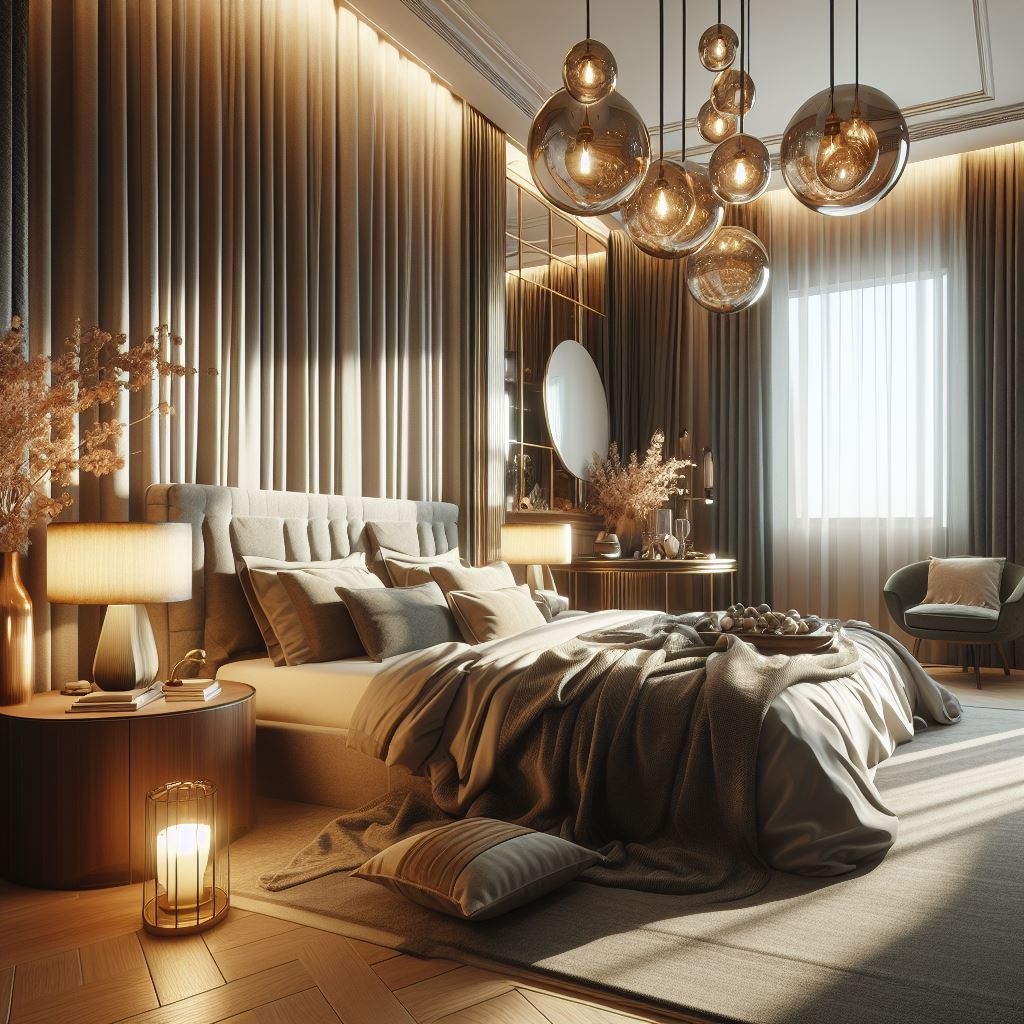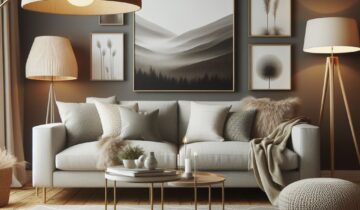Introduction
When it comes to creating a comfortable and relaxing bedroom environment, lighting plays a crucial role. The right lighting can help you unwind and prepare for a good night’s sleep, while the wrong lighting can disrupt your sleep patterns and make it difficult to relax. In this guide, we’ll take a closer look at the different types of bedroom lighting, their functions, and how to choose the perfect lighting for your bedroom.

Understanding Your Lighting Needs
Before we dive into the different types of bedroom lighting, it’s important to understand your lighting needs. Consider the following factors:
- Natural Light: Natural light is the most important factor to consider when it comes to bedroom lighting. If your bedroom has large windows or skylights, you may not need as much artificial lighting during the day.
- Activities: Think about the activities you’ll be doing in your bedroom. Will you be reading, watching TV, or working? Different activities require different levels of lighting.
- Mood: Lighting can greatly impact the mood of your bedroom. Do you want a relaxing and calming atmosphere, or a bright and energizing one?
Types of Bedroom Lighting
Now that you have a better understanding of your lighting needs, let’s take a look at the different types of bedroom lighting:
1. Overhead Lighting
Overhead lighting is the most common type of bedroom lighting. It provides a general light source for the entire room and can be used to illuminate the space when natural light is not available. There are several options for overhead lighting, including:
- Ceiling Fixtures: Ceiling fixtures are the most common type of overhead lighting. They can be recessed, flush-mounted, or pendant lights.
- Chandeliers: Chandeliers are a popular choice for bedrooms, especially those with high ceilings. They provide a touch of elegance and can be used to create a relaxing atmosphere.
2. Task Lighting
Task lighting is used to illuminate specific areas of the bedroom, such as a reading nook or a dressing table. It’s important to choose task lighting that provides enough light for the specific task without creating harsh shadows or glare. Some popular task lighting options include:
- Table Lamps: Table lamps are a versatile and affordable option for task lighting. They can be placed on a bedside table, dresser, or desk.
- Floor Lamps: Floor lamps are another popular option for task lighting. They can be placed in a corner or against a wall to provide lighting for a specific area.
3. Accent Lighting
Accent lighting is used to create a visual interest in the bedroom. It can be used to highlight a piece of artwork, a sculpture, or a architectural feature. Some popular accent lighting options include:
- Wall Sconces: Wall sconces are a popular choice for accent lighting. They can be used to create a warm and inviting atmosphere and can be placed in a variety of locations, including the bedside, bathroom, or hallway.
- Spotlights: Spotlights are a great option for highlighting a specific feature in the bedroom, such as a piece of artwork or a sculpture. They can be placed on a wall or ceiling and can be adjusted to shine in different directions.
4. Mood Lighting
Mood lighting is used to create a specific atmosphere in the bedroom. It can be used to create a relaxing and calming environment, or a bright and energizing one. Some popular mood lighting options include:
- Dimmer Switches: Dimmer switches allow you to adjust the brightness of your lighting to create a specific mood. They can be used with overhead lighting, table lamps, or floor lamps.
5. Mood Lighting
Mood lighting is used to create a specific atmosphere in the bedroom. It can be used to create a relaxing and calming environment, or a bright and energizing one. Some popular mood lighting options include:
- Dimmer Switches: Dimmer switches allow you to adjust the brightness of your lighting to create a specific mood. They can be used with overhead lighting, table lamps, or floor lamps.
- Color-Changing Lights: Color-changing lights are a great option for creating a unique and relaxing atmosphere in the bedroom. They can be set to change colors automatically, or you can control them manually.
- LED Light Strips: LED light strips are a versatile and affordable option for mood lighting. They can be placed under the bed, around the windows, or in other creative locations to create a relaxing ambiance.
6. Energy Efficiency
Energy efficiency is an important consideration when choosing bedroom lighting. Look for lighting options that are energy-efficient and have a long lifespan. Some popular energy-efficient lighting options include:
- LED Bulbs: LED bulbs are a popular choice for energy-efficient lighting. They use significantly less energy than traditional incandescent bulbs and can last up to 25 times longer.
- CFL Bulbs: CFL bulbs are another energy-efficient option for bedroom lighting. They use less energy than traditional incandescent bulbs and can last up to 10 times longer.
7. Safety
Safety is an important consideration when choosing bedroom lighting. Look for lighting options that are safe and easy to use. Some popular safety features include:
- Safety Switches: Safety switches are a great option for bedroom lighting. They automatically turn off the light if they detect a problem, such as a loose connection or a short circuit.
- Safety Covers: Safety covers are a great option for table lamps and floor lamps. They protect the light bulb from being touched or knocked over, reducing the risk of injury.
8. Design and Style
Design and style are important considerations when choosing bedroom lighting. Look for lighting options that complement the style and decor of your bedroom. Some popular design and style options include:
- Modern: Modern lighting options are sleek and stylish. They are often made from materials such as metal, glass, or acrylic and have a minimalist design.
- Traditional: Traditional lighting options have a classic and timeless design. They are often made from materials such as wood, bronze, or brass and have a more ornate design.
- Rustic: Rustic lighting options have a natural and earthy design. They are often made from materials such as wood, stone, or metal and have a more rugged and natural look.
9. Smart Lighting
Smart lighting is a great option for bedroom lighting. Smart light bulbs can be controlled using a smartphone or tablet, allowing you to turn the lights on and off, adjust the brightness, and even change the color of the light from the comfort of your bed. Some popular smart lighting options include:
- ** Philips Hue**: Philips Hue is a popular smart lighting system that offers a range of color and white light bulbs that can be controlled using a smartphone or tablet.
- LIFX: LIFX is another popular smart lighting system that offers a range of color and white light bulbs that can be controlled using a smartphone or tablet.
- Sylvania Smart+: Sylvania Smart+ is a smart lighting system that offers a range of color and white light bulbs that can be controlled using a smartphone or tablet.

10. Outdoor Lighting
Outdoor lighting can be used to illuminate the exterior of your home, creating a safe and welcoming environment. Some popular outdoor lighting options include:
- Pathway Lighting: Pathway lighting is used to illuminate walkways, driveways, and other outdoor pathways. It can be used to create a warm and inviting ambiance and to improve safety by providing adequate lighting for guests and family members.
- Security Lighting: Security lighting is used to illuminate the exterior of your home and to deter intruders. It can be used to highlight potential security risks, such as dark corners and blind spots, and to provide adequate lighting for security cameras.
- Landscape Lighting: Landscape lighting is used to highlight the beauty of your outdoor landscaping. It can be used to illuminate trees, gardens, and other outdoor features, creating a warm and inviting ambiance.
By considering these factors, you can choose the perfect lighting options for your home. Remember to always follow safety guidelines and choose lighting options that are safe and easy to use.

FAQ:
Q: What are the different types of home lighting?
A: There are several types of home lighting, including:
- Ambient lighting: Provides overall illumination for a room or space.
- Task lighting: Used for specific tasks, such as reading or cooking.
- Accent lighting: Used to highlight certain features or objects in a room.
- Decorative lighting: Used for aesthetic purposes, such as creating a warm and inviting atmosphere.
Q: What are some energy-efficient lighting options for my home?
A: Some energy-efficient lighting options for your home include:
- LED bulbs: Use significantly less energy than traditional incandescent bulbs and can last up to 25 times longer.
- CFL bulbs: Use less energy than traditional incandescent bulbs and can last up to 10 times longer.
- Smart lighting systems: Can be controlled remotely and automatically turn off when not in use.
- Solar-powered lighting: Uses renewable energy from the sun and can be used for outdoor lighting.
Q: How can I create a warm and inviting atmosphere in my home with lighting?
A: You can create a warm and inviting atmosphere in your home with lighting by:
- Using soft, warm lighting: Use table lamps, floor lamps, or pendant lights with soft shades to create a warm and cozy atmosphere.
- Adding dimmers: Install dimmers to adjust the brightness of your lighting and create a relaxing ambiance.
- Using layered lighting: Use a combination of ambient, task, and accent lighting to create a layered and inviting atmosphere.
- Incorporating natural light: Open curtains and blinds during the day to let natural light in and use skylights or solar tubes to bring in natural light.
Q: How can I ensure that my home is well-lit for safety purposes?
A: You can ensure that your home is well-lit for safety purposes by:
- Installing bright lights at entrances: Install bright lights at entrances to illuminate the area and deter potential intruders.
- Using motion-sensing lights: Install motion-sensing lights in areas where you may encounter obstacles or need extra lighting, such as in the garage or basement.
- Adding night lights: Use night lights in hallways and bedrooms to provide a source of light during the night.
- Avoiding dark corners: Use task lighting or accent lighting to illuminate dark corners and reduce the risk of tripping or falling.
Q: Can lighting affect my mood and well-being?
A: Yes, lighting can affect your mood and well-being. Research has shown that exposure to natural light can improve mood, energy levels, and overall well-being. In addition, the color temperature and brightness of lighting can also impact your mood and energy levels. For example, cool white light can increase alertness and energy, while warm white light can promote relaxation and calmness.
Q: How can I incorporate smart lighting into my home?
A: You can incorporate smart lighting into your home by:
- Installing smart light bulbs: Replace traditional light bulbs with smart light bulbs that can be controlled using a smartphone or tablet app.
- Using a smart lighting hub: Connect your smart light bulbs to a smart lighting hub, such as Amazon Echo or Google Home, to control your lights with voice commands.
- Installing smart light switches: Replace traditional light switches with smart light switches that can be controlled using a smartphone or tablet app.
- Using smart lighting systems: Install smart lighting systems, such as Philips Hue or LIFX, that can be controlled using a smartphone or tablet app and offer features such as scheduling and color changing.




 No products in the cart.
No products in the cart.